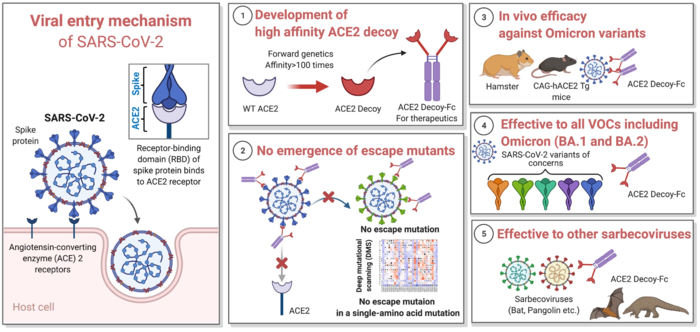Researchers from Japan have found that the best defense against COVID-19 infection could be a good decoy.
In a recently published study, researchers from Osaka University and Kyoto Prefectural University of Medicine have revealed that a specially designed ‘decoy’ virus receptor reduces the infectivity of the severe acute respiratory syndrome coronavirus 2 (SARS-CoV-2) Omicron variant in cells and experimental animal models.
Most current treatments for SARS-CoV-2 infection involve antibodies that have been designed to neutralize the virus. However, the effectiveness of these antibodies varies depending on the virus variant, and the virus can rapidly develop mutations that help it ‘escape’ neutralization. An alternative strategy is to use decoys that imitate the SARS-CoV-2 receptor, angiotensin-converting enzyme 2 (ACE2). With this approach, the virus binds to the ACE2 decoy instead of to cells expressing the actual ACE2 protein, so the virus never comes into contact with or enters the cells.
“By engineering small mutations into ACE2, we were able to improve its affinity for the spike protein of SARS-CoV-2, to the point where it was able neutralize the virus just as well as therapeutic antibodies do,” says Atsushi Hoshino, senior author on the study. “However, the Omicron variant of SARS-CoV-2 has many new mutations in the spike protein, so we wanted to know whether our engineered ACE2 was also effective in preventing infection with this variant.” To do this, the researchers infected cells with different variants of SARS-CoV-2 and treated them with the engineered ACE2 decoy.
“The results were very clear,” explains Hoshino. “The engineered ACE2 effectively neutralized the Omicron variant of SARS-CoV-2, to a level comparable to that seen with the original Wuhan variant.”
In addition, treating hamsters or mice with the engineered ACE2 protected them from Omicron, resulting in less severe infection and improved chance of survival.
“Our findings suggest that ACE2 is a useful therapeutic option for treating a wide variety of SARS-CoV-2 variants, including Omicron,” explains Hoshino.
Furthermore, a detailed analysis of the mutations found in the Omicron variant is highly unlikely to ‘escape’ neutralization by the ACE2 decoy, unlike the virus’s tendency to rapidly evade neutralization by antibody-based treatments. Given that the engineered ACE2 was also able to neutralize other viruses related to SARS-CoV-2 that typically infect animals, it is possible that this strategy could also be beneficial for managing future disease outbreaks.
The paper, “An engineered ACE2 decoy neutralizes the SARS-CoV-2 Omicron variant and confers protection against infection in vivo,” was published in Science Translational Medicine at DOI: https://doi.org/10.1126/scitranslmed.abn7737
